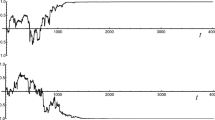Abstract
It is emphasized that the collapse postulate of standard quantum theory can violate conservation of energy-momentum and there is no indication from where the energy-momentum comes or to where it goes. Likewise, in the Continuous Spontaneous Localization (CSL) dynamical collapse model, particles gain energy on average. In CSL, the usual Schrödinger dynamics is altered so that a randomly fluctuating classical field interacts with quantized particles to cause wavefunction collapse. In this paper it is shown how to define energy for the classical field so that the average value of the energy of the field plus the quantum system is conserved for the ensemble of collapsing wavefunctions. While conservation of just the first moment of energy is, of course, much less than complete conservation of energy, this does support the idea that the field could provide the conservation law balance when events occur.
Similar content being viewed by others
REFERENCES
P. Pearle, New Techniques in Quantum Measurement Theory, D. M. Greenberger, ed. (New York Acadamy of Science, New York, 1986), p. 539.
L. Vaidman (private communication) and L. Goldenberg (M.Sc. thesis, Tel-Aviv University, 1995), in a similar discussion of conservation of the mean value of the energy, conclude that certain measurements, assumed to be energy conserving, cannot be perfect (i.e., error free). The present argument goes further, in showing that even certain imperfect measurements cannot be energy conserving. I would like to thank Lev Vaidman for bringing this work to my attention.
D. Bohm and J. Bub, Revs. Mod. Phys. 38, 453 (1966).
P. Pearle, Phys. Rev. D 13, 857 (1976); Int'l. J. Theor. Phys. 48, 489 (1979); Found. Phys. 12, 249 (1982); in Quantum Concepts in Space and Time, R. Penrose and C. J. Isham, eds. (Clarendon, Oxford, 1986), p. 84.
P. Pearle, The Wave-Particle Dualism, S. Diner et al., eds. (Reidel, Dordrecht, 1984).
P. Pearle, Phys. Rev. A 39, 2277 (1989).
G. C. Ghirardi, A. Rimini, and T. Weber, Phys. Rev. D 34, 470 (1986); Phys. Rev. D 36, 3287 (1987); Found. Phys. 18, 1 (1988).
G. C. Ghirardi and A. Rimini, Sixty-Two Years of Uncertainty, A. Miller, ed. (Plenum, New York, 1990), p. 167.
G. C. Ghirardi, P. Pearle, and A. Rimini, Phys. Rev. A 42, 78 (1990).
G. C. Ghirardi and P. Pearle, PSA 1990, Vol. 2, A. Fine, M. Forbes, and L. Wessels, eds. (Philosophy of Science Association, Michigan, 1990) pp. 19, 35.
P. Pearle, Open Systems and Measurement in Relativistic Quantum Theory, H. P. Breuer and F. Petruccione, eds. (Springer, Heidelberg, Germany, 1999), p. 195.
P. Pearle and E. Squires, Phys. Rev. Lett. 73, 1 (1994).
B. Collett, P. Pearle, F. Avignone, and S. Nussinov, Found. Phys. 25, 1399 (1995).
P. Pearle, J. Ring, J. I. Collar, and F. T. Avignone III, Found. Phys. 29, 465 (1999).
P. Pearle, Phys. Rev. D 29, 235 (1984); A. Zeilinger, Quantum Concepts in Space and Time, R. Penrose and C. J. Isham, eds. (Clarendon, Oxford, 1986); A. Zeilinger, R. Gaehler, C. G. Shull, W. Treimer, and W. Mampe, Revs. Mod. Phys. 60, 1067 (1988).
A. J. Leggett, Found Phys. 29, 445 (1999).
J. R. Clauser, Experimental Metaphysics, R. S. Cohen, M. Horne, and J. Stachel, eds. (Kluwer Academic, Dordrecht, 1997), p. 1.
F. Karolyhazy, Nuovo Cimento A 42, 1506 (1966). F. Karolyhazy, A Frenkel, and B. Lukacs, Physics as Natural Philosophy, A. Shimony and H. Feshbach, eds. (M.I.T. 1159 Wavefunction Collapse and Conservation Laws Press, Cambridge, 1982), p. 204; Quantum Concepts in Space and Time, R. Penrose and C. J. Isham, eds. (Clarendon, Oxford, 1986), p. 109; A. Frenkel, Found. Phys. 20, 159 (1990).
R. Penrose, Quantum Concepts in Space and Time, R. Penrose and C. J. Isham, eds. (Clarendon, Oxford, 1986), p. 129; The Emperor's New Mind (Oxford University Press, Oxford, 1992); Shadows of the Mind (Oxford University Press, Oxford, 1994); Gen. Rel. and Grav. 28, 581 (1996).
L. Diosi, Phys. Rev. A 40, 1165 (1989).
G. C. Ghirardi, R. Grassi, and A. Rimini, Phys. Rev. A 42, 1057 (1990).
P. Pearle and E. Squires, Found. Phys. 26, 291 (1996).
L. E. Ballentine, Phys. Rev. A 43, 9 (1991).
J. Anandan, Found. Phys. 29, 1647 (1999).
D. Bedford and D. Wang, Nuovo Cim. B 26, 313 (1975); B 37, 55 (1977).
I. C. Percival, Proc. Roy. Soc. A 451, 503 (1995).
L. P. Hughston, Proc. Roy. Soc. A 452, 953 (1995).
L. Diosi, Phys. Lett. A 129, 419 (1988).
Author information
Authors and Affiliations
Rights and permissions
About this article
Cite this article
Pearle, P. Wavefunction Collapse and Conservation Laws. Foundations of Physics 30, 1145–1160 (2000). https://doi.org/10.1023/A:1003677103804
Issue Date:
DOI: https://doi.org/10.1023/A:1003677103804




